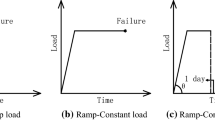Abstract
Proof loading concept is a recognized quality control technique to improve the characteristics of the lower tail of strength distributions of structural timber products. Very few comprehensive studies are available to quantify the effectiveness on the use of proof loading relating to the choice of proof load level, the potential damage on the members resulting from the application of proof load, and the improvement of performance in the context of reliability based design methods. One of the difficulties is the need of a rather large sample size for an experimental-based study to develop statistically meaningful solutions. This paper illustrates the use of damage accumulation model and reliability based design analyses to quantify the effectiveness of proof loading. The performance of No. 2 and better Western Hemlock 38×140 mm dimension lumber in bending is considered. Damage accumulation laws are established to consider the residual strength of members that survived a proof load. Reliability analyses are conducted to compare the performance of proof-loaded and non-proof loaded members subject to snow load conditions in two locations in Canada. For a given reliability index (β), the improvement of performance can be quantified as characteristic strength adjustment factors for proof loading in terms of the ratio of the performance factors (φ) between the original and proof load material. Conversely the gain in reliability, β, for a given φ value is also apparent. The adjustment factors depend on the proof load level, the β level, and the distribution selected for fitting the strength data after proof loading.
Zusammenfassung
Testbelastung ist ein anerkanntes Kontrollverfahren, um die Charakteristik der Festigkeitsverteilung von Holzkonstruktionen im niedrigeren Bereich zu verbessern. Nur eine geringe Anzahl von umfassenden Untersuchungen steht zur Verfügung, umd die Effektivität dieser Methode für ein bestimmtes Lastniveau zu quantifizieren, mögliche Schäden an Konstruktionsgliedern durch das Verfahren und die Sicherheit entsprechender Konstruktionsmethoden abzuschätzen. Eine der Schwierigkeiten besteht in der Notwendigkeit großer Probenabmessungen, wenn statistisch relevante Lösungen abgeleitet werden sollen. Diese Arbeit beleuchtet die Anwendung des Modells der Schadensakkumulation und der Sicherheitsanalyse von Konstruktionen, um die Effektivität der Testbelastung zu quantifizieren. Anhand des Leistungstests Nr. 2 und besserer Schnittholzdimensionen (38×140 mm, Hemlocktanne) wird die Biegefestigkeit geprüft. Regeln der Schadensakkumulation werden aufgestellt, um die Restfestigkeit nach der Prüfung abzuschätzen. Sicherheitsanalysen zum Vergleich von belasteten und unbelasteten Gliedern unter Schneelast in zwei Regionen Kanadas wurden durchgeführt. Für einen gegebenen Sicherheitsindex (β) kann die Qualitätsverbesserung quantifiziert werden anhand eines charakteristischen Anpassungsfaktors, ausgedrückt als Verhältnis der Qualitätsfaktoren (φ) des ursprünglichen und des geprüften Materials. Zugleich wird der Sicherheitsgewinn (β) bei einem gegebenen φ-Wert deutlich.Der Anpassungsfaktor hängt ab von dem Lastniveau, dem β-Niveau und der gewählten Verteilung zum Anpassen der Festigkeitsdaten nach dem Test.










Similar content being viewed by others
References
Foschi RO, Folz BR, Yao FZ (1989) Reliability-based design of wood structures. Structural Research Series, Report No. 34, Department of Civil Engineering, University of British Columbia, Vancouver, British Columbia, Canada
Leicester RH (1988) Rouge factors in proof grading. In: Proceedings 1988 International Conference on Timber Engineering, Seattle, Washington 1:345–350
Woeste FE, Green DW, Tarbell KA, Marin LA (1987) Proof loading to assure lumber strength. Wood Fiber Sci 19:283–297
Author information
Authors and Affiliations
Corresponding author
Additional information
The authors gratefully acknowledge NSERC Canada for funding support to the research program (FSP 0166869). The funding by STINT (The Swedish Foundation for International Cooperation in Research and Higher Education) has enabled S. Svensson to participate in this project.
Rights and permissions
About this article
Cite this article
Lam, F., Abayakoon, S., Svensson, S. et al. Influence of proof loading on the reliability of members. Holz Roh Werkst 61, 432–438 (2003). https://doi.org/10.1007/s00107-003-0418-1
Published:
Issue Date:
DOI: https://doi.org/10.1007/s00107-003-0418-1




